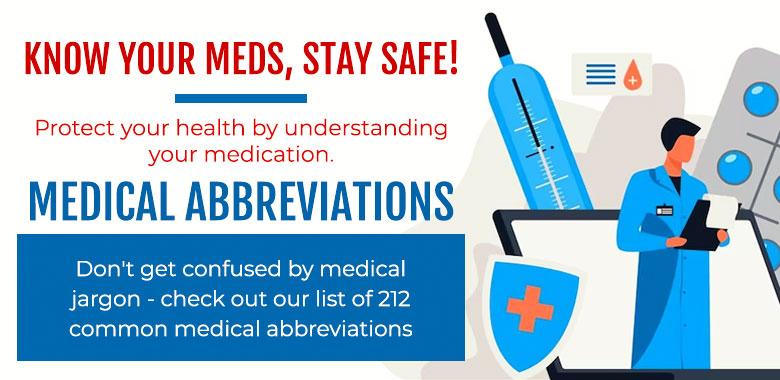Decoding Medical Terminology in Prescriptions: A Comprehensive List of 212 Commonly Used Medical Abbreviations
Doctors and healthcare professionals are busy people who need to save time and use space efficiently in their prescriptions. This is where medical abbreviations come in handy. They allow healthcare providers to communicate important information quickly and accurately, particularly in emergencies where every second counts. But as important as these abbreviations are, they can be confusing and even dangerous if not understood by patients. Misinterpreting an abbreviation can lead to serious consequences like taking the wrong medication or dose, or even an overdose.
Some abbreviations have multiple meanings, adding to the potential for confusion. Patients should always ask their healthcare provider to explain any abbreviation they don’t understand to avoid errors. By taking the time to understand these abbreviations, patients can ensure they take their medications correctly and at the right time, leading to better health outcomes.
Stop Feeling Lost and Confused – Read Below to Discover Our Comprehensive List of 212 Common Medical Abbreviations and Unlock the Secrets of Your Prescriptions!Abbreviation Meaning a Before aa Of each ac Before meals ad Right ear ad lib As desired AFB Acid-fast bacillus AG Silver (argentum) alt. dieb. Every other day am Morning AMA Against medical advice amb Ambulate, walk ANA Antinuclear antibody ant Anterior APAP Acetaminophen approx. Approximately aq Water aq ad iniect. In water for injection AS Left ear ASA Acetylsalicylic acid (Aspirin) AU Both ears b Twice BID Twice a day BM Bowel movement BP Blood pressure BRP Bathroom privileges BUN Blood urea nitrogen c With Ca Calcium cap Capsule CBC Complete blood count cc Cubic centimeter CHF Congestive heart failure Cl Chlorine cm Centimeter CNS Central nervous system CO2 Carbon dioxide COPD Chronic obstructive pulmonary disease CP Chest pain CPR Cardiopulmonary resuscitation CSF Cerebrospinal fluid CVA Cerebrovascular accident CXR Chest x-ray d Day D5W Dextrose 5% in water D/C or DC Discontinue DNR Do not resuscitate dr Dram DS Double strength DW Dextrose in water Dx Diagnosis ECG or EKG Electrocardiogram EEG Electroencephalogram EMG Electromyogram ER Emergency room et And ET Endotracheal ETOH Alcohol F Fahrenheit Fe Iron FF Force fluids fl. oz. Fluid ounce FS Frozen section Fx Fracture g Gram gal Gallon GC Gonorrhea GCS Glasgow Coma Scale GERD Gastroesophageal reflux disease GI Gastrointestinal gtt Drop GU Genitourinary h Hour H2O Water Hb or Hgb Hemoglobin HCl Hydrochloric acid HCO3- Bicarbonate Hct Hematocrit HEENT Head, eyes, ears, nose, throat Hgb Hemoglobin HOB Head of bed H&P or HPI History and physical examination HS At bedtime HTN Hypertension Hx History
Did you know that medical abbreviations can have different meanings based on context? Always check with your healthcare provider to clarify any you don’t understand.
| I&D | Incision and drainage |
| I&O | Intake and output |
| IBW | Ideal body weight |
| ICU | Intensive care unit |
| ID | Intradermal |
| IJ | Internal jugular |
| IM | Intramuscular |
| INH | Isoniazid |
| inj | Injection |
| IO | Intraosseous |
| IPPB | Intermittent positive pressure breathing |
| IUD | Intrauterine device |
| IV | Intravenous |
| K | Potassium |
| KCL | Potassium chloride |
| kg | Kilogram |
| L | Liter |
| L&D | Labor and delivery |
| LEEP | Loop electrosurgical excision procedure |
| LLQ | Left lower quadrant |
| LP | Lumbar puncture |
| LS | Lumbosacral |
| m | Minim |
| mEq | Milliequivalent |
| mg | Milligram |
| mL or ml | Milliliter |
| mm | Millimeter |
| mmHg | Millimeters of mercury |
| mod | Moderate |
| MRSA | Methicillin-resistant Staphylococcus aureus |
| MS | Morphine sulfate |
| mU | Milliunits |
| N/V or N/V/D | Nausea, vomiting, diarrhea |
| Na | Sodium |
| NAD | No acute distress |
| NG or ng | Nasogastric |
| NICU | Neonatal intensive care unit |
| NIDDM | Non-insulin dependent diabetes mellitus |
| NKDA | No known drug allergies |
| NPO | Nothing by mouth |
| NS | Normal saline |
| NTG | Nitroglycerin |
| O&P | Ova and parasites |
| O2 | Oxygen |
| OB | Obstetrics |
| OD | Right eye |
| OS | Left eye |
| OU | Both eyes |
| p | After |
| p.c. or pc | After meals |
| p.o. or po | By mouth |
| p.r.n. or prn | As needed |
| p.t. or pt | Prothrombin time |
| p.v. or pv | Vaginally |
| PALS | Pediatric Advanced Life Support |
| para | Parity |
| PCN | Penicillin |
| PCA | Patient-controlled analgesia |
| PDA | Patent ductus arteriosus |
| PERRLA | Pupils equal, round, reactive to light and accommodation |
| pH | Hydrogen ion concentration |
| PID | Pelvic inflammatory disease |
| PMH | Past medical history |
| p.o. or po | By mouth |
| p.r.n. or prn | As needed |
| post-op | Postoperative |
| pre-op | Preoperative |
| prep | Preparation |
| prn | As needed |
| PT | Physical therapy |
| PT/INR | Prothrombin time/international normalized ratio |
| q | Every |
| q.d. or qd | Daily |
| q.h. or qh | Every hour |
| q.2h or q2h | Every 2 hours |
| q.3h or q3h | Every 3 hours |
| q.4h or q4h | Every 4 hours |
Remember, always follow your healthcare provider’s instructions for taking medications, even if you’re familiar with the abbreviation used. Never hesitate to ask for clarification if you’re unsure.q.6h or q6h Every 6 hours q.8h or q8h Every 8 hours q.12h or q12h Every 12 hours q.i.d. or qid Four times a day q.o.d. or qod Every other day q.s. or qs Quantity sufficient q.t. or qt Quart R Respiration R/O Rule out RBC Red blood cell RDS Respiratory distress syndrome REM Rapid eye movement RICE Rest, ice, compression, elevation RLL Right lower lobe RLQ Right lower quadrant ROM Range of motion ROS Review of systems RSV Respiratory syncytial virus Rx Prescription s Without SIDS Sudden infant death syndrome SL Sublingual SOB Shortness of breath sq Subcutaneous SSRI Selective serotonin reuptake inhibitor stat Immediately STD Sexually transmitted disease subq or subcut Subcutaneous sup or supp Suppository Sx Symptoms T Temperature tab Tablet TENS Transcutaneous electrical nerve stimulation tid Three times a day TPN Total parenteral nutrition TPR Temperature, pulse, respiration tr Treatment TSH Thyroid-stimulating hormone UA Urinalysis UGI Upper gastrointestinal UTI Urinary tract infection VA Visual acuity VDRL Venereal Disease Research Laboratory VS Vital signs w With WBC White blood cell WPW Wolff-Parkinson-White syndrome wt Weight y.o. or yo Years old μg or mcg Microgram μL or mcL Microliter
This is a complete list of commonly used medical abbreviations in prescriptions, along with their meanings. It’s important to note that not all medical abbreviations are appropriate for all medical settings and situations, and their use should always be guided by proper medical knowledge and practice.
Fun fact: The most commonly used medical abbreviation is Rx, which stands for ‘prescription’. How many of these abbreviations did you already know?
In medical charting, the abbreviation “X” is often used to indicate exceptions to defined limits in the patient’s findings or assessment. It signifies that there are abnormal findings within a specific category or parameter. For example, during a cardiac assessment, if a patient has pink, warm, and dry skin, but also has an audible murmur, the presence of the murmur would be indicated by using “X” to represent an exception to the normal cardiac assessment.
This shorthand allows healthcare professionals to quickly signal that there are deviations from expected or defined limits. Following the use of “X,” a focused assessment would typically be documented to provide specific details about the abnormal findings. An alternative to using “X” is using the abbreviations “WNL” (within normal limits) or “WDL” (within defined limits) to denote that the patient’s findings are within the expected range.
In the field of nursing in the USA, numerous common terms and abbreviations are used to communicate important information and instructions. Some of these include:

Medical abbreviations are crucial for efficient communication among healthcare providers. However, misinterpreting or misusing these abbreviations can have serious consequences for patients. Accurate interpretation and use of medical abbreviations are vital to ensure that patients receive the right medication and dosage at the right time. This section explores the significance of accurately interpreting and using medical abbreviations for patient safety.
Patients may encounter various medical terminology on their prescription labels and packaging. Understanding these terms is crucial to ensure proper medication use and avoid potential harm. Here are some common terms and tips for understanding them:
Tips for understanding these terms:
By understanding these terms, patients can ensure safe and effective medication use.
It’s important to seek advice from a healthcare provider if patients have questions about their prescription.
Self-interpretation can lead to serious consequences, including:
Consulting with a healthcare provider can:
Patients should never be afraid to ask their healthcare provider for clarification or further explanation. It’s important to take medication as directed for optimal health outcomes.
Thank you for taking the time to learn about medical abbreviations and other terminology that you may encounter in your prescription. By understanding these terms and asking your healthcare provider for clarification when needed, you can help ensure that you take the correct medication at the right time and dose. Remember, misinterpreting an abbreviation can have serious consequences, so it’s essential to read and follow the instructions carefully.
On this page, we have provided you with a list of 212 commonly used medical abbreviations, along with their meanings and explanations. Keep this reference handy and don’t hesitate to ask your healthcare provider to explain any abbreviation you don’t understand.
Your health and safety are our top priority, and we hope that this page has helped you feel more confident in understanding your prescription instructions. Take care and always stay informed.